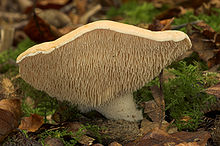| Hydnaceae | |
|---|---|

| |
| Hydnum repandum | |
| Scientific classification | |
| Domain: | Eukaryota |
| Kingdom: | Fungi |
| Division: | Basidiomycota |
| Class: | Agaricomycetes |
| Order: | Cantharellales |
| Family: | Hydnaceae Chevall., 1826 |
| Type genus | |
| Hydnum | |
| Genera | |
|
Burgoa (anamorph) | |
| Synonyms[1] | |
|
Repetobasidiaceae Jülich | |
The Hydnaceae are a family of fungi in the order Cantharellales. Originally the family encompassed all species of fungi that produced basidiocarps (fruit bodies) having a hymenium (spore-bearing surface) consisting of slender, downward-hanging tapering extensions referred to as "spines" or "teeth",[2] whether they were related or not. This artificial but often useful grouping is now more generally called the hydnoid or tooth fungi. In the strict, modern sense, the Hydnaceae are limited to the genus Hydnum and related genera, with basidiocarps having a toothed or poroid hymenium. Species in the family are ectomycorrhizal, forming a mutually beneficial relationship with the roots of trees and other plants. Hydnum repandum (the hedgehog fungus) is an edible species, commercially collected in some countries and often marketed under the French name pied de mouton.